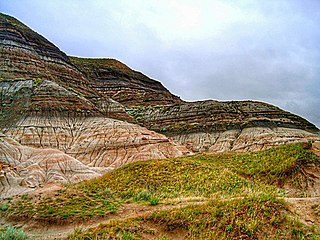2012 end of the world in history: dinosaur extinction and Chicxulub Yucatan comet

Badlands near Drumheller, Alberta, where erosion has exposed the KT boundary. From Wikipedia Commons: This work has been released into the public domain by its author, Glenlarson at the english wikipedia project. This applies worldwide.
In editing the End of the World 2012 movie, I’m at the place where I’m looking at previous end of the world scenarios, specifically where I intereview physicist Dr. William Petrachenko on the extinction of the dinosaurs 65 million years ago. Dr. Petrachenko works in the field of geophysics.
It turns out that the dinosaur extinction is associated with a worldwide characteristic in rock strata called the Cretaceous Tertiary Layer or Boundary or K – T Boundary. (This has recently been amended to the K-Pg or Cretaceous-Paleogene Boundary.) Coincidentally, the K-T Boundary occurs at about 65 million years ago.
As Dr. Petrachenko explains in the movie, at the K-T Layer, scientists have found a higher concentration than is usually found on earth of Iridium. Since comets and asteroids have high concentrations of iridium, the scientists theorized that a huge extraterrestrial object must have hit the earth about 65 million years ago and that the debris or ejecta from the impact would have been carried in the atmosphere all around the earth and fell to the surface creating the K-T Boundary.
Since the extinction of the dinosaurs and this comet/asteroid impact occurred at about the same time–65 million years ago–scientists hypothesized that the comet/asteroid impact led to the extinction of the dinosaurs.
In the photo, above right, rocks above the K-T Boundary are much darker than the lighter-colored rocks below the K-T Boundary. The iridium is found in a narrow band, not visible in this long distance photo, between the two layers.
In the End of the World 2012 Movie, we visit Chicxulub, Yucatan, where the comet exploded 65 million years ago. For more information on the K-T Boundary/K-Pg Boundary, Iridium and the Chicxulub Impact, please see the Wikipedia article, Cretaceous-Paleogene boundary.